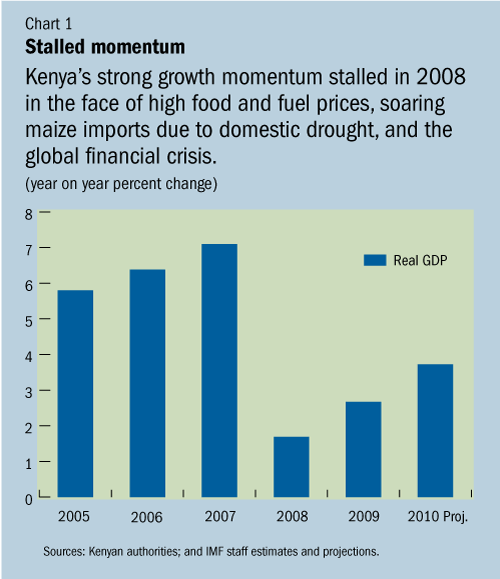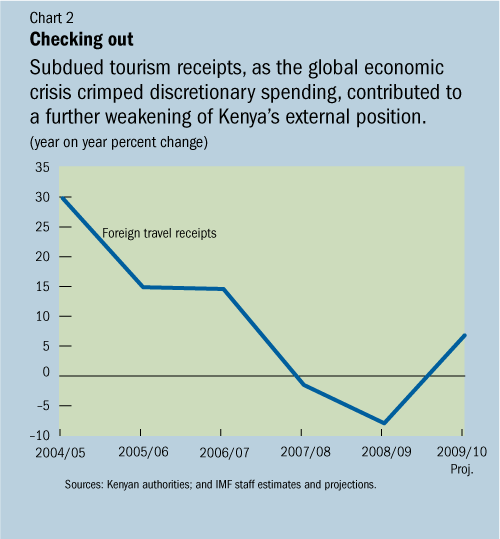
Typical street scene in Santa Ana, El Salvador. (Photo: iStock)
IMF Survey: IMF Shocks Loan, Policy Changes Help Kenya's Recovery
January 8, 2010
- Kenyan economy buffeted in 2008 by high food and fuel prices, drought
- IMF loan helped close financing gaps, enabling orderly rebuilding of reserves
- More infrastructure investment, structural reform bills passage are key
Less than a year after drawing on an emergency loan from the IMF, Kenya is showing tentative signs of economic recovery.

Sugar cane harvest in Kenya, where government’s budget targets extra spending on infrastructure, food security, pro-poor programs (photo: Newscom)
ECONOMIC HEALTH CHECK
Kenya’s $200 million June 2009 drawdown from an IMF facility designed to buffer economies from shocks caused by events beyond their control allowed the country to close financing gaps that opened up during 2008.
Kenya’s strong growth momentum during the 2004–07 period stalled in 2008 due to a series of adverse developments (see Chart 1). Recovery from post-election violence that had disrupted agricultural and manufacturing production was cut short by high fuel and food prices. In addition, high maize imports due to domestic drought weakened the external position.
The global financial crisis led to steep decline in private capital flows, and subdued exports and tourism receipts (see Chart 2) all contributed to a further weakening of the external position. Official foreign exchange reserves fell by almost $800 million (about 20 percent of the stock of reserves) between mid-2008 and early 2009, increasing the country’s vulnerability to further shocks. On the capital market, there was substantial capital outflow from the Nairobi Stock Exchange, where the key share index declined by 35 percent in 2008 alone.
Domestic policy adjustments and improvements in the world economy helped Kenya turn in a better economic performance this year, the IMF said in its regular assessment of the country’s economy. As a result, Kenya’s real GDP growth is now projected to accelerate to 3.2 percent in 2009/10, from 2.2 percent in 2008/09. However, some important tasks, especially in the implementation of structural reforms, remain unfinished.

IMF financing, coupled with appropriate policy adjustments and implementation of some structural measures, is contributing to the nascent economic recovery in 2009/10. However, the economy is still growing at below its precrisis rates, and growth is likely to be subdued at least until 2011/12.
Financing gaps
In mid-2009 Kenya requested IMF financial assistance under the rapid access component of the Exogenous Shocks Facility, a loan program designed to help low-income countries cope with emergencies caused by events beyond their control. The $200 million loan helped Kenya to close the financing gaps estimated for 2008/09 and 2009/10 while enabling an orderly rebuilding of foreign reserves.

Kenya’s policy adjustments to address the effects of the economy’s 2008 shocks have focused on four key areas.
Fiscal policy: The fiscal framework sought to strike the right balance between adjusting to the shocks, stimulating the economy, and maintaining medium-term debt sustainability. At the onset of the crisis, the authorities recognized the need to mitigate the impact of the shocks on the poor and vulnerable, as well as to stimulate the economy. As a result, fiscal policy aimed to be countercyclical. The 2009/10 budget targeted additional expenditure on infrastructure, food security, and pro-poor programs. Sound macroeconomic policies and progress made in reducing public debt-to-GDP ratios in the recent past gave the government some fiscal space to support higher levels of expenditure, while departing only moderately and temporarily from its fiscal anchor of a 40 percent ratio of debt to GDP.
Monetary policy: Since the onset of the global financial crisis, the Central Bank of Kenya has sought to maintain a countercyclical monetary policy stance. The policy interest rate and the cash reserve requirement were reduced by a total of 125 and 150 basis points respectively during 2008–09. Combined with weakening aggregate demand in the economy, this helped provide ample liquidity and kept interest rates subdued. The growth rate of monetary aggregates remained below target, and revised consumer price data that were recently published indicate that the inflation environment has been relatively benign.
Financial sector policy: Financial sector policy aimed to contain the direct adverse impact of the global financial crisis. The central bank, for example, stepped up the supervision of banks at the onset of the crisis to detect emerging stresses in the system, and accommodated urgent financial needs of banks at that time. This partly contributed to commercial banks introducing stricter appraisal of new credit facilities, increased monitoring of existing credit portfolios, and limited exposure to foreign currency risks. To deepen capital market operations, the minimum capitalization of investment banks and stockbrokers was increased.
Exchange rate policy: The policy remained that of a floating exchange rate regime with the exchange rate reflecting economic fundamentals. Interventions are limited to smoothing out excessive volatilities, and rebuilding of reserves. This policy has supported macroeconomic stability by helping the economy absorb terms of trade and other exogenous shocks.
Next steps
Given the government’s vision of accelerating economic growth in the medium term and making Kenya a middle-income country by 2030, additional investment in infrastructure and strong implementation of structural reforms are key. The decision to frontload key infrastructure investments in the 2009/10 budget is welcome, but considerations need to be given to advancing structural reforms as follows:
• Fiscal policy implementation would be enhanced by the enactment of the Public Finance Management Bill, which aims at revising the legal framework for public finance management to ensure appropriate budget execution, accounting, and internal audit. In addition, enactment of the Public Private Partnership Bill would establish a sound framework for regulating their operations and managing associated risks.
• Financial sector stability and development would benefit from faster progress in addressing shortcomings in the supervisory and regulatory framework of both the banking system and the capital market. Enactment of the Banking Act (Amendment) Bill would strengthen the central bank’s hand by authorizing consolidated supervision and prompt corrective action. Capital market depth and regulation would be further enhanced by the enactment of the Deposit Insurance, National Payment System, and Demutualization of the Stock Exchange bills.


